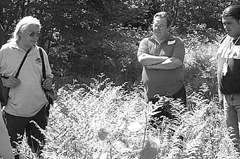The University Record, January 31, 2000 By Britt Halvorson

We are threatened by the loss of a rich reflection of cultural traditions and values and something very important to our understanding of the human intellect. That something is language, according to Marianne Mithun, linguist at the University of California, Santa Barbara, and the featured speaker at a Martin Luther King Jr. Symposium lecture.
Mithun discussed “Alternative Possibilities of the Human Mind: Viewing the World through the Languages Indigenous to North America” at a Jan. 21 program sponsored by the Program in Linguistics and the Department of Anthropology.
Approximately 300 American Indian languages reflecting great diversity exist in North America. The 300 languages, according to Mithun, originated from 50 to 60 distinct language families north of Mexico, meaning that many of the languages contain a unique structure and syntax. For example, Mohawk only has nine consonants, whereas some native Californian languages have 45.
The first European explorers who traveled to North America, Mithun noted, were “stunned” by the different languages spoken by Native Americans. “The real appreciation for how different [the] languages are has come about very slowly,” Mithun said.
European settlers had a “terrible impact” on all aspects of American Indian cultures, including language. Foreign diseases to which most Native Americans had never before been exposed weakened and decreased the size of many communities. Assimilation tactics imposed by European settlers altered many cultural traditions and the teaching of language. Some Europeans felt that the native languages were “barbaric,” while others’ good intentions of teaching English and Spanish to Native Americans actually worked toward the demise of native languages.
Linguists, Mithun said, have felt that work needs to be done as soon as possible to document these dead or dying languages. Today, with just a few exceptions, it is often only the older generation that is able to speak a language. Many communities have difficulty keeping young children and teenagers interested in learning their native language and cultural traditions.
“From week to week, we don’t know how many languages are around. There are probably about half left,” Mithun said. The number of speakers of all Native American languages, except those of the Inuit, is decreasing rapidly.
“The loss of these languages is a striking blow to the descendants of the speakers of these languages,” Mithun added. “It’s a tremendous loss intellectually—these are amazing human systems. We lose the workings of the human mind.”
Through language, Mithun said, we see reflections of the natural environment as well as how people live. Many Native American languages show polysynthesism, a “propensity toward words with an elaborate internal structure.” The Mohawk word tenhsatianakarhatho, for example, means “you’re going to put your shoe on the wrong foot.”
By closely examining different languages, Mithun said, “you see the world dissolve into this other order.”
Mithun illustrated the varied ways in which different cultures express ideas by telling the audience about a simple experiment she designed. She counted the number of nouns and verbs in English and Mohawk sentences, in order to find noun-to-verb ratios for each language. In English, the ratio was an equal one-to-one. However, in Mohawk, she discovered the ratio to be one noun to every 17 verbs.
Gender also is expressed differently. In Mohawk, a feminine pronoun is used for the unspecified, in contrast to the “he” that has been used in English until recently. Blackfoot breaks entities down into animate and inanimate genders. Such words as “man” and “elk” are considered animate, while “lake” and “meat” are inanimate. And Yuchi of Oklahoma assigns a completely different gender to non-Yuchi people.
Space, action, control and possession also reflect the ways in which different Native American groups view each other, proper etiquette, values and the natural world. In several native languages, Mithun commented, space is not just seen as concrete space, but often takes into account mental space too.
Yup’ik uses different demonstratives depending on the location of the object, for example. Speakers will denote if an object is seen for a brief moment or partially visible, directly visible, or behind another object or not visible at all. A pair of mittens will usually be marked with a “restricted” demonstrative, meaning that the items are in full view, Mithun commented, but if one mitten is missing, a Yup’ik speaker will use an “extended” demonstrative instead, letting the listener know that both are not present or visible.
Central Pomo speakers always specify the source of their information. Five words exist that mean in English “it rained,” but each one contains a different tinge of reasoning, whether it be that the person observed drops of rain on someone’s parka or heard someone else say that it was raining.
“They make these distinctions all the time in ways that English speakers do not,” Mithun noted. “They do it effortlessly, but were stunned to see it broken down [on paper].”
The development of each Native American language, Mithun said, has taken place over centuries. In the beginning of the language’s evolution, certain parts of it became routinized and what speakers have chosen to use most often has been adjusted and shaped and passed down generation after generation.
Linguists can make communities aware of the value and richness of their language and make themselves available as resources, Mithun said. However, linguists have to be very sharp and accurate, she noted, because no one else may be able to document a dying language.
In accord with the message of Martin Luther King Jr., Mithun said that work to preserve Native American languages must also address the empowerment of minorities.
“If we really want to know what is special about a language, we’ve got to let the speakers do the talking,” Mithun concluded.

